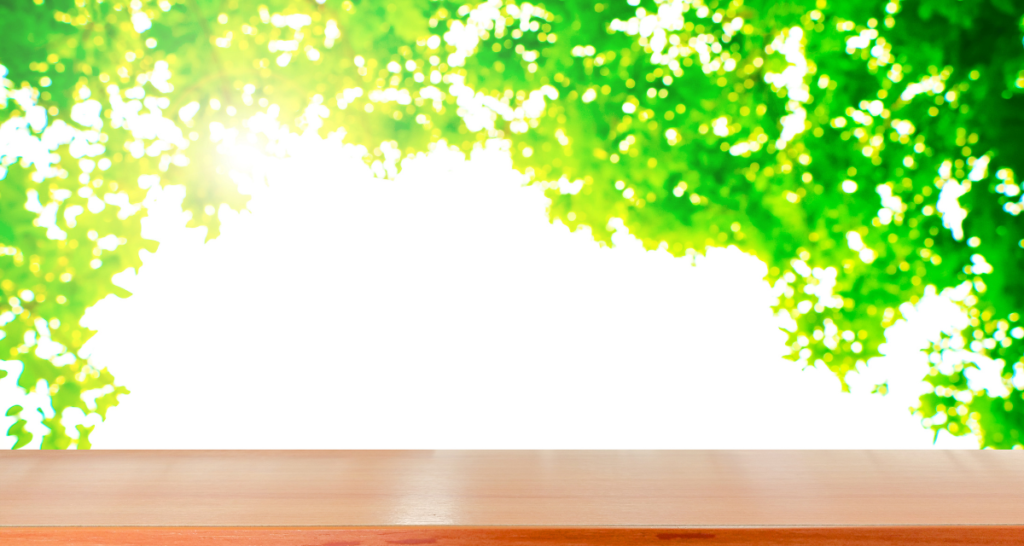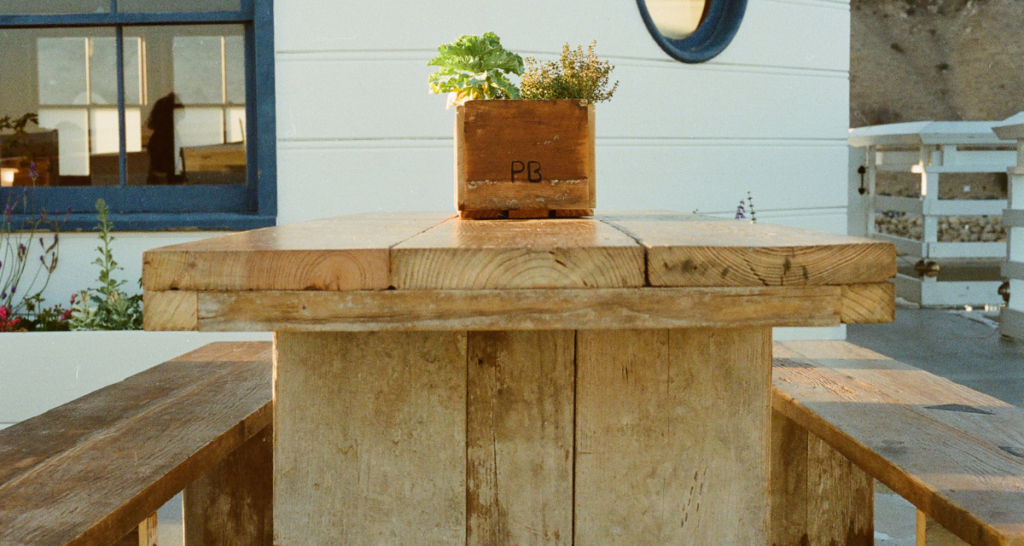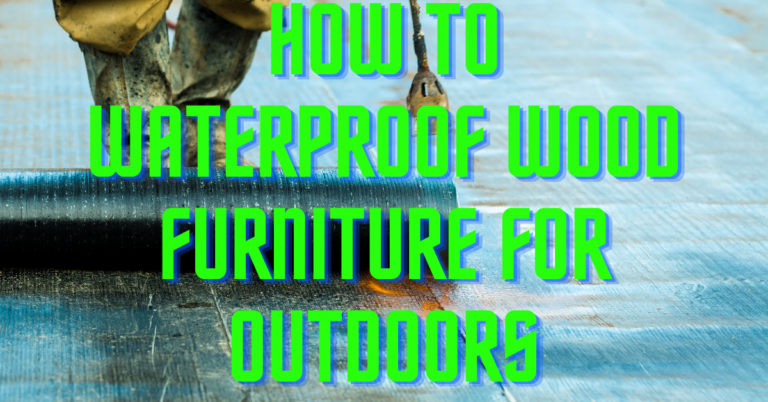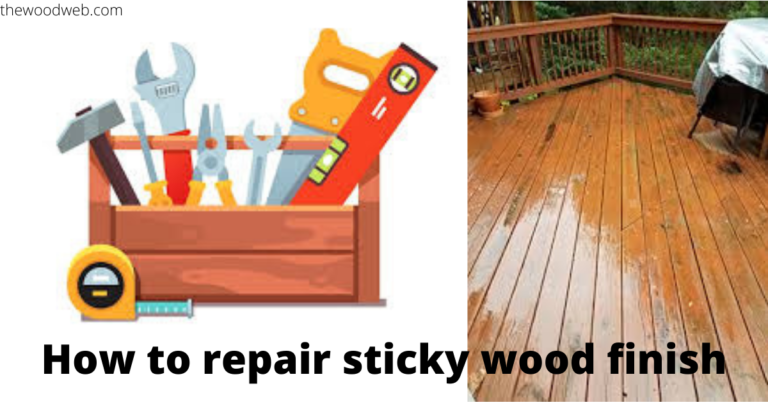The Best way to Seal a Wood Table Top [Expert’s Opinion]
Some of the best pieces of furniture ever made are wood crafted. Wood material has been in existence for centuries, and that’s why it’s the most used building material for making furniture and cabinet.
However, wood material is susceptible to moisture, insects, and damage, so it warps and wears out without protection. For a wood tabletop, it even gets worse due to frequent use.
For this reason, you must seal it. Sealing a wood table involves many processes, such as sanding, brushing/ spraying with a specific varnish or product on the table, staining (this is optional), etc.
Seeing these processes may make you feel that sealing a wood tabletop is challenging, but it isn’t in a real sense. It’s not so complicated, provided you understand the steps and the nature of the finish you are applying.
Most finishes, if not all, contain certain chemicals and natural products like acrylic resins, which seal and protect the wood. I’ll discuss several ways on how to seal a wood table top successfully.
All at a Glance
Why Should You Seal a Wood Tabletop?
Sealing your wood tabletop has numerous advantages. It protects the wood from wearing out and prolong its use.
Second, sealing will maintain the beauty and value of the wood. Have you ever noticed why some wood surfaces stay beautiful even after so many years? The reason for that is because the wood has been sealed.
How to Seal a Wood Tabletop

As I stated, there are ways you can seal a wood tabletop. You can seal a wood tabletop using some of the following finishes;
Lacquer Formula Linseed or Tung oil Varnish Polyurethane, though each of these finishes has a slightly different way of applying them, it doesn’t take away the fact that they will completely seal your wood tabletop.
Before we go into further details on applying these finishes, it’s essential to note that these finishes are broadly categorized into two – penetrating finishes and surface finishes.
Penetrating finishes are those that soak and dry inside the wood. They are easier to apply and usually leave a more natural look.
Examples of penetrating finishes are linseed oil and Tung oil. Surface finishes are those that dry on the surface of the wood.
They don’t look as natural as penetrating finishes but are more durable. Surface finishes are better choices for wood products that are used every day to minimize wear and tear.
Examples of surface finishes are varnish, shellac, and polyurethane. Although surface finishes dry on the surface, most of the first coat is absorbed into the wood, but subsequent coats dry on the surface by clinging to the first.
Sealing a Wood Tabletop Using Lacquer
Formula Lacquer is a glossy material gotten from a mixture of tree resin dissolved in alcohol. Lacquer is one of the essential sealants for coating or sealing wood furniture.
Many woodworking experts and professionals consider lacquer as the best sealant because of its unique properties.
It dries super fast and is convenient to apply, especially with spray guns. The formula brings out the best of wood surfaces, in this case, wood tabletop. Although lacquer may leave behind a yellowish appearance after a few years, the surface is warm and has a scratch-resistant finish.
Different types of lacquer exist, but the most common types are nitrocellulose and pre-catalyzed lacquer.
Regarding wood, we will only discuss the pre-catalyzed formula as nitrocellulose is mainly used on musical instruments. The trade-off of using lacquer formula is that they give off strong fumes.
This type of finish requires that you work with it in a well-ventilated area. Else, the fumes will choke you.
How to Seal a Wood Tabletop with Lacquer
You will need the following tools to seal a wood tabletop with lacquer;
- Masks
- Gloves
- Safety glasses.
- Lacquer formula
- Natural bristle brush/ spray guns
- Sandpaper (120-grit and 180-grit sandpaper)
- Rags
Step 1: Prepare the Surface
Start by cleaning the surface. If the body has been finished previously, you’ll need to strip off the old finish by sanding it off with 60-grit sandpaper.
However, you need to check the edges to determine if the tabletop is wood or veneer. If the tabletop is veneer, avoid sanding it because veneered table tops have only one thin wood layer. Sanding it off will damage the wood ultimately.
Sand the tabletop lightly with 120-grit sandpaper in long parallel strokes. The tabletop must be evenly smooth. If there are holes or gouges on the tabletop, fill them all up with a mixture of sawdust gotten from sanding and some glue.
Step 2: Clean the Surface
Use a clean, dry cloth to wipe the surface off specks of dust, debris, and other foreign particles.
Alternatively, you can use a vacuum cleaner for the best results. You must thoroughly clean the surface for the next process.
Step 3: Apply a Thin Coat
Before you start with the application, you need to wear some protective clothing. Put on a protective mask, chemical-resistant gloves, and glasses if possible.
The best way to apply lacquer is by using a spray gun because it allows the particles to penetrate the wood surface.
However, if you are not comfortable with a spray gun, you can use a natural bristle brush. Apply a thin coat to the wood tabletop with a spray gun or brush, starting with the edges until the surface is evenly painted or sprayed.
Step 4: Allow It to Dry
After applying the first coat, allow the formula to dry for a few hours.
Step 5: Sand the Surface Again
Sand by hand using 180-grit sandpaper to obtain a smooth surface.
Step 6: Apply the Second Coat
After sanding, follow up with the second coat of lacquer. Usually, two coats are enough, but you can add as many coats as possible if you want more depth.
The coats will cure into a robust finish. Sealing a Wood Tabletop with linseed and Tung oil Linseed and Tung oil are derived from the flax plant’s seeds and the Chinese Tung tree.
For centuries, carpenters have used these oils to protect woods, such as oak, walnut, etc. Even in modern times, linseed and Tung oil are still essential wood sealants. Like lacquer, linseed, and Tung oil dry pretty fast.
Unlike lacquer, the oil-blended formula doesn’t give off an irritating smell. For best results and to eliminate stickiness, you can blend the oils with ingredients like mineral spirit and polyurethane.
How to Seal a Wood Tabletop with Linseed and Tung oil

Here are what you need to carry out this task successfully;
- Linseed oil
- Tung oil
- Mineral Spirit
- Polyurethane
- Natural bristle brush/ foam stick/ stirrer120-grit and 180-grit
- SandpapersRags/ dry cloth
Step 1: Prepare the Surface
Start by sanding the surface gently with 120-grit sandpaper. After filing, vacuum the surface or clean it with a rag/ dry cloth. Remember to fill all the holes on the surface, if any.
Step 2: Mix the Ingredients
Mix one part of linseed, one part of Tung oil, one part of the mineral spirit, and one part of polyurethane in a bowl and stir thoroughly.
Step 3: Apply with a Brush
Using a natural bristle brush, apply the oil-blended mixture to the wood tabletop surface. Allow the oil to soak into the wood surface and apply evenly. Remember that the coat must be thin and not thick.
Step 4: Wipe Off Any Excesses and Allow It to Dry
Clean any excess oil with a clean rag or dry cloth and allow the mixture to dry. It could take several hours for the wood to dry wholly. While waiting for the first coat to dry, you need to keep the brush from drying out.
You have to either wash off the finish or store it in a container of mineral spirits to retain its softness until you’re ready to use it again.
Step 5: Sand Lightly
Using 180-grit sandpaper, sand the surface gently. Sand the edges and the corners of the tabletop until the area is evenly sanded.
Step 6: Apply Another Coat
Apply the second coat with the natural bristle brush to the wood surface. You can repeat this coating process as many times as you wish if you are yet to obtain the desired result.
Sealing a Wood Tabletop with Varnish

Most varnishes are high-gloss topcoats mainly used for outdoor/ exterior projects and woods that frequently contact water. They provide wood with added protection.
How to Seal a Wood Tabletop with Varnish You will need a varnish, like Spar varnish, natural bristle brush, tack cloth, stirrer/ stick, and sandpaper (120-grit and 180-grit sandpaper).
Step 1: Sand the Surface
Sand the surface carefully with 120-grit sandpaper. Vacuum the surface/ clean it with a rag/ dry cloth after sanding. Fill all the holes on the surface, if any, with fillers.
Step 2: Apply the First Coat with a Natural Bristle Brush
Stir, and not shake the container with a stick or stirrer. Apply a thin coat with the natural bristle brush evenly on the surface in horizontal strokes. Start from the edges and the corners.
Step 3: Allow to Dry
Allow the wood surface to dry for about an hour or two. Clean off any excesses. Store your brush to prevent the finish from drying out or wash the varnish off.
Step 4: Sand Lightly
As the wood dries, it may accumulate dust particles, which may cause roughness and affect the final finish. For this reason, you need to sand it again with fine-grit sandpaper.
For smooth sanding, apply some mineral oil to the dried wood and sand the surface with light pressure in the wood’s grain direction. Wipe off any excess oil and the specks of dust.
Step 5: Apply the Second Coat
Add the second coat with the same natural bristle brush. Repeat the same process in step 2. If you wish to apply another coat, allow the surface to dry, and sand it with 220-grit sandpaper. Then apply the third coat after removing excess dust.
Sealing a Wood Tabletop with Polyurethane
Polyurethane is one of the most used finishes because of its excellent sticking and drying property. It cures into a durable, tough finish after being applied.
Polyurethane exists in two forms – water-based and oil-based polyurethane. Water-based has a low odor and toxic level. When dry, it leaves a clear finish on the surface without any slight color. It dries very fast as well but can’t handle heat and chemicals.
Oil-based poly, on the other hand, is more durable and can withstand heat and chemical exposure. However, it leaves a slight amber color on the wood’s surface once it cures.
How to Seal a Wood Tabletop with Polyurethane
Sealing with polyurethane requires the following tools;
- Water-based or oil-based formula
- Paintbrushes (natural bristle brush for an oil-based and synthetic brush for water-based)
- Sandpaper (120-grit, 180-grit, and 220-gritTack or dry cloth
- Thinning agent (mineral spirits for oil-based and water for water-based polyurethane)
- A mixing container
- A bowl for cleaning your brush
Step 1: Remove the Dust & Prepare the Surface
Before any application, ensure that you sand the surface adequately. Start with the 120-grit sandpaper. Remove any dust particles or debris afterward with a tack cloth or vacuum machine.
Step 2: Avoid Shaking the Can
Polyurethane is thick in the can, and shaking it will cause bubbles to form. When transferred to the work surface, it can make the finishing ugly. To reduce these curb bubbles, mix three parts of the oil-based poly with one part of the mineral spirit in an empty container and stir.
If you opt for water-based, mix three parts of it with one water in an empty container and stir. Wear a mask when dealing with oil-based polyurethane because it’s toxic and gives off a strong smell.
Step 3: Apply Thin Coats
Polyurethane finish is better when you first apply multiple thin coats rather than one thick coat. Use a natural bristle brush for oil-based polyurethane and synthetic/nylon for water-based polyurethane, as earlier stated.
Dip the brush into the poly container and apply in horizontal, even strokes, starting from the middle.
Step 4: Allow the Finish to Dry
After you have applied the first coat, allow the finish to dry. The waiting time is between a few hours to a day. Use a tack cloth to wipe off any excess finish.
Step 4: Sand Between Coats
After the coat must have been dry, sand the surface with 180-grit sandpaper to smoothen it. Clean the dust generated from the sanding process afterward.
Step 5: Apply the Second Coat
Using a natural bristle brush for oil-based polyurethane and synthetic/nylon for water-based polyurethane, apply the second coat, just as you did in step 3. Allow the finish to dry and clean any excess finish. If you wish to attain more depth in your finish, you can apply more coats.
All you have to do is sand in between with finer-grit sandpapers and follow the same application method from step 3.
Conclusion
If you want your wood tabletop to last longer and stay beautiful, sealing it with the right finish is paramount. A sealed wood tabletop is better protected than those that aren’t sealed.
With all the steps of applying different finishes explained here, I’m sure you have learned a thing or two about how to seal a wood tabletop without any professional help.







